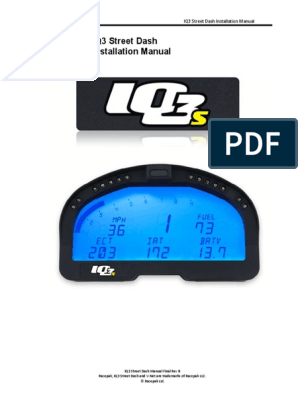0% found this document useful (0 votes)
168 views21 pagesMicrosquirt IObox 1
The document provides information about using a Microsquirt as an input/output (I/O) box with Megasquirt-3 or MS3-Pro engine management systems. When using the IObox firmware, the Microsquirt can provide 7 analog inputs, 4 switch inputs that can also be used as 2 wheel speed inputs, 6 PWM outputs, and 1 low current output. All configuration is done through TunerStudio software on the MS3/MS3-Pro. The I/O functions have fixed purposes to simplify setup. The I/O box has some delay due to CAN communication but is suitable for functions like data logging and fan control rather than time-critical controls. Wiring and configuration instructions are included
Uploaded by
jesus roblesCopyright
© © All Rights Reserved
We take content rights seriously. If you suspect this is your content, claim it here.
Available Formats
Download as PDF, TXT or read online on Scribd
0% found this document useful (0 votes)
168 views21 pagesMicrosquirt IObox 1
The document provides information about using a Microsquirt as an input/output (I/O) box with Megasquirt-3 or MS3-Pro engine management systems. When using the IObox firmware, the Microsquirt can provide 7 analog inputs, 4 switch inputs that can also be used as 2 wheel speed inputs, 6 PWM outputs, and 1 low current output. All configuration is done through TunerStudio software on the MS3/MS3-Pro. The I/O functions have fixed purposes to simplify setup. The I/O box has some delay due to CAN communication but is suitable for functions like data logging and fan control rather than time-critical controls. Wiring and configuration instructions are included
Uploaded by
jesus roblesCopyright
© © All Rights Reserved
We take content rights seriously. If you suspect this is your content, claim it here.
Available Formats
Download as PDF, TXT or read online on Scribd
/ 21






























































































